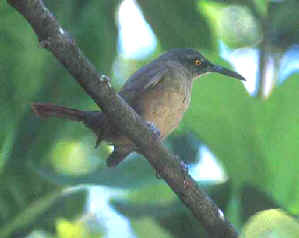
E-mail: font@focusonnature.com
Phone: Toll-free in USA 1-888-721-3555
or 302/529-1876
Website: www.focusonnature.com
 |
PO
Box 9021, Wilmington, DE 19809, USA E-mail: font@focusonnature.com Phone: Toll-free in USA 1-888-721-3555 or 302/529-1876 Website: www.focusonnature.com |
A Focus On Nature Tour
in the northern islands of
the
LESSER
ANTILLES
ANTIGUA, BARBUDA,
MONTSERRAT,
GUADELOUPE
and
DOMINICA
For Birds, Butterflies,
and Other Nature
on these beautiful Caribbean islands
March 5-13, 2016
(tour: FON/WI-4 '16)
For
Endemic & Specialty Birds,
on islands also interesting to visit for other reasons
On Barbuda: an
endemic, aptly named the
Barbuda Warbler.
On
Montserrat: the endemic Montserrat Oriole;
On
Guadeloupe: the endemic Guadeloupe Woodpecker
Both of these, also aptly named, in addition to other birds.
On Dominica:
endemic & rare Imperial
& Red-necked Parrots,
and two superb specialties: the Plumbeous Warbler & Forest Thrush.
Also during this tour: an
opportunity for some wonderful cetacean-watching,
with whales & dolphins, in addition to pelagic birds.

The Brown Trembler on Dominica
This tour follows one
on the large Caribbean Island
of Hispaniola
for endemic & specialty birds
in the
Dominican Republic
(tour FON/WI-3)
February 27 - March 5,
2016
Links:
Itinerary for the preceding tour in the Dominican Republic, FON/WI-3
A
List of Lesser Antilles Birds & Some Other Nature
A List of Photo Gallery of Caribbean Birds, in 2 parts:
Part #1: Guineafowl to
Hummingbirds
Part #2: Trogons to Buntings
Rare Birds of the Caribbean, Now & in the Past
Caribbean Butterflies (with some photos)
Amphibians & Reptiles of the Caribbean (with some photos)
Fish of
the Caribbean Other Marine Life (including Corals, Jellyfish,
Mollusks, Arthropods)
Some
Highlights of previous FONT tours in the Lesser Antilles
Itinerary (prices follow):
Sat, Mar 5:
A mid-day arrival on the Caribbean island of Antigua,
in the northern Lesser Antilles. Some afternoon birding. Overnight on Antigua.
Sun, Mar 6: A day-trip from Antigua to the small island of
Barbuda. That
flat 62 square-mile island is 26 miles north of Antigua. There's 17 miles of
white sandy beach. (Sand is the main export.) Most of the island's 1200
inhabitants live in Codrington. It should be noted, however, that nesting terns,
turtles, and frigatebirds outnumber the human residents of the island by at
least 10 to 1. Goats, guineafowl, deer, and wild boar roam the roads. There's a
bird sanctuary that we'll visit, with mangroves and a lagoon, where frigatebirds
nest. Other birds occur there too, and one of the species we're aiming to see on
the island is one endemic to the small island, the Barbuda Warbler. (It was at
one time 1 of 3 subspecies of the Adelaide's
Warbler.) Overnight back in
Antigua.
Mon & Tue, Mar 7 & 8:
These two days, on the
island of Montserrat. The morning of March 7 we'll take a short 15-minute flight
from Antigua to Montserrat.
Montserrat is about 25 miles southwest of Antigua. But in contrast with Barbuda
(about the same distance from Antigua, in the opposite direction), there are in
Montserrat no white sand beaches as the island is volcanic. Montserrat is called
the "Emerald Isle of the Caribbean", not just due to the greenness of
the lush rain forest, but because a number of Europeans who settled the island
were from Ireland. Wildlife in the forest includes a number of interesting
regional endemics: tree frogs, dwarf geckos, anoles, and the "mountain
chicken" (actually a frog). There's also kind of a half-snake, half-lizard
galliwasp. 34 species of birds are said to resident, but the one we'll put the
most effort into seeing will be the rare national bird of the island, the
Montserrat Oriole.
One of the places that we'll visit during our stay on the island will be the
Montserrat Volcano Observatory. In 1995, there was a major volcanic eruption on
the island. That eruption, as well as Hurricane Hugo, a few years earlier in
1989, had quite a bad impact on many things, including the Montserrat Oriole.
But, the bird still exists, and, as just said, we'll make a good effort to see
it at the best recommended places (we're told that the area of a particular
spring near a ghaut is good). A "ghaut" is a local name for a ravine.
During our time in Montserrat, we're sure to learn more interesting things.
We'll spend 2 overnights there.
Wed, Mar
9:
This day, after the
short 15-minute flight from Montserrat back to Antigua, we'll connect onto a
flight to the island of Dominica, where
we'll spend this, and the next 2 nights.
Birding on Dominica will begin as
soon as we arrive on the island. Overnight on Dominica.
Thu, Mar 10: A full-day on Dominica, a spectacular island of peaks, ridges, and ravines. About half of the small island is over 1,000 feet above sea level. About three-fourths of the island is covered by forest, the most forest existing in the West Indies. And most of that forest is lush, either categorized as "rain" or "cloud" forest. In it, some special birds are to be found. Among them: the rare Forest Thrush, the localized Plumbeous Warbler, the Rufous-throated Solitaire (with its beautiful song), and 2 species of endemic parrots. Dominica is the only island in the Caribbean where 2 species of Amazons occur: the Red-necked and the Imperial - the latter, the largest of the parrots in the Caribbean. Overnight on Dominica.
Fri, Mar 11: Another day of birding and experiencing Dominica (both onshore & offshore). This day, as we have during previous Dominica tours, we'll take a boat-trip off the coast of the island. Birds in the area, above the water, have included for us in the past White-tailed Tropicbird, Red-footed Booby, and both Pomarine and Great Skuas. At the surface of the water, and below, we've seen some interesting marine mammals: both Great Sperm Whales and Dwarf Sperm Whales, and one time a pod of over 200 of the rarely-seen Fraser's Dolphins. Later in the day, a ferry-ride from Dominica to the nearby island of Guadeloupe.
Sat, Mar 12:
This day, on the island of
Guadeloupe. It's not really just an island, it's an archipelago.
Whatever it is, it's French. Guadeloupe is called the "Butterfly
Island", not because there are butterflies there (even though there are,
and we'll certainly see some of them), but due to the shape of the island, or
archipelago. However, it'll be a woodpecker that will be our primary quest on
Guadeloupe. The Guadeloupe Woodpecker is endemic to Guadeloupe, and it's the
only member of the woodpecker family in all of the Lesser Antilles. The "Tapeur"
as the woodpecker is called in Guadeloupe, from the French word
"taper", meaning "to tap"), is a dark bird, rather
similar, in fact closely related to the Lewis's Woodpecker of the American West.
It's relatively common (in the right areas), but one has to go to Guadeloupe to
see it. And that we will. And of course, we'll see some other nice birds and
sights in Guadeloupe. Overnight on Guadeloupe.
Sun, Mar 13: After some final
exploration and birding on Guadeloupe, we'll
transfer to the airport for the departing flights for home.
![]()
Price:
US$ 2,595 per person based on double-occupancy.
Single-supplement: US$ 375
Includes:
All
accommodations.
All meals (except those on Mar 5 & 13).
Ground transportation on the various islands.
Services of the guide.
Permits for entries to national forest land and restricted areas.
Does not include:
Meals on Mar 5 & 13.
Drinks & any other items of a personal nature.
Gratuities.
Air transportation to/from and between the islands.
Tour to be led by Armas Hill.
A deposit of US
$500 is required to reserve a place on the tour.